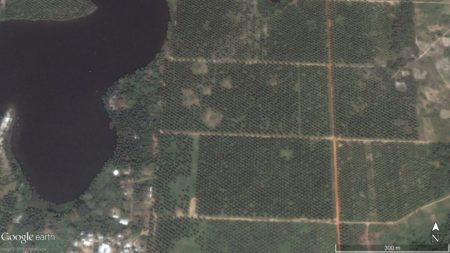My recent post about lighting strikes in a coconut genebank was picked up by the excellent Coconut Google Group and generated some interesting responses. In particular, there’s a comment from Charles Clement of the National Institute of Amazonian Research in Manaus, Brazil recounting how a high-velocity wind blast — an Amazonian wind storm — took out a large chunk of his peach palm (Bactris gasipaes) genebank. Ex situ conservation in field genebanks can be a risky business indeed. The solutions are clear: more replications within collections, cleverly distributed in space; safety duplication of the entire collection somewhere else entirely (in vitro or as seeds as appropriate); and complementary conservation in situ. But that all costs money. I would say that most food crop accessions maintained in field genebanks around the world are unique. Take coconut. The Coconut Genetic Resources Database records 1416 accessions from 28 genebanks in 23 countries. More than 600 of them are represented by a single accession.
African Agroecological Alternatives to the Green Revolution
We will strongly oppose and fight against such policies and practices promoted as “a new green revolution for Africaâ€.. Instead of solving the main problems for Africa, the Green Revolution will exacerbate current problems and create new problems in the long run. Their policy is environmental unsustainable, and will create more hunger and poverty.
Fighting talk from the 150 people who gathered for a series of conferences at the Nyéléni centre in Selengue, Mali, between 26 November and 2 December. Read the rest of the outcome statement here, and the conference documents here.
Will it make a hill of beans’ worth of difference? Depends, but one cannot help agreeing with the conference participants’ own conclusion:
We agreed that the real test of the significance of our week at the Nyéléni centre will be what we are doing in practice in the next weeks, months and years.
Indeed. And on the support they receive, no doubt.
Seed conservation: cold, or dry?
Another fine guest post from Jacob van Etten.
Places with extreme conditions are good for conservation, whether it be Timbuktu with its dry, hot climate for books or Spitsbergen with its freezing cold for crop seeds. Next year the seeds will start to come to Spitsbergen from across the world to stock the “doomsday seed vaultâ€. Right now the vault is being cooled down, to be reaching -18°C soon.
Low temperatures are key to ex situ conservation of seeds. Cold chambers and freezers stuffed with seeds are found near any plant scientist around the world. The Svalbard project is not only unique because of the size of the vault but also because of its location. The low temperatures on the island will make the vault less expensive to cool as well as less vulnerable to energy failure, a common preoccupation of seed bank managers in those countries where tropical temperatures, unreliable energy networks and unpaid bills tend to converge. An alternative solution, however, seems to be on the horizon. The latest Technology Quarterly section of The Economist runs an interesting story about dry storage of biological materials at room temperature. Wrapped in polymers or sugars, DNA molecules are less vulnerable to degeneration. Perhaps this technology will also be available to seeds some day?
Three into one for new wheat
Scientists at the Australian CSIRO and Sydney University, working with colleagues at CIMMYT in Mexico, have built a chromosome that brings together the disease resistance genes of two wild wheat species into a single genetic package. 1 This should make life easier for wheat breeders; while they may be able to find valuable genes in wheat’s wild relatives, those genes are often accompanied by large blocks of other genes that often bring bad qualities. Getting the harmful genes out of the cross is apparently sometimes so difficult that breeders give up.
Thinopyrum intermedium (intermediate wheatgrass) contributed resistance to barley dwarf yellow virus, while Th. ponticum (tall wheatgrass) supplied a couple of rust resistance genes. They are both on the short arm of one of the wheat chromosomes, but without the baggage normally associated with genes from wild relatives. Crosses with bread wheats resulted in fertile offspring with the required resistance. These are being used to study the genes further in search of molecular markers that will help breeders to identify valuable crosses.
According to a press release:
By developing new DNA markers and by careful testing the team has produced a number of the disease resistance packages for wheat breeders, making it faster and easier to include these important disease resistance traits in future wheat varieties.
Lightning strikes coconuts twice (and more)
I’m still in the Philippines, but I’ve moved from rice to coconuts. That’s in terms of what I’m discussing, not what I’m eating. I’m participating in a meeting of the curators of the five different regional components of the International Coconut Genebank, organized by COGENT. There’s a lot of interesting stuff coming out, but what I wanted to share with you now (it’s actually the afternoon tea break) is something that was shown earlier today 2 to illustrate the problems that conservation of coconuts in field genebanks can face.
The image below comes from Google Earth and shows a small piece of one of the largest and most important coconut genebanks in the world, at the Marc Delorme Research Station just outside Abidjan, Ivory Coast. Those large gaps in the otherwise beautifully laid out genebank were caused by lightning strikes! The labourers grow their cassava there now. I’d never heard of this particular threat to ex situ conserved agrobiodiversity. This particular parcel seems to have been particularly unlucky, attracting strikes repeatedly over the years.
